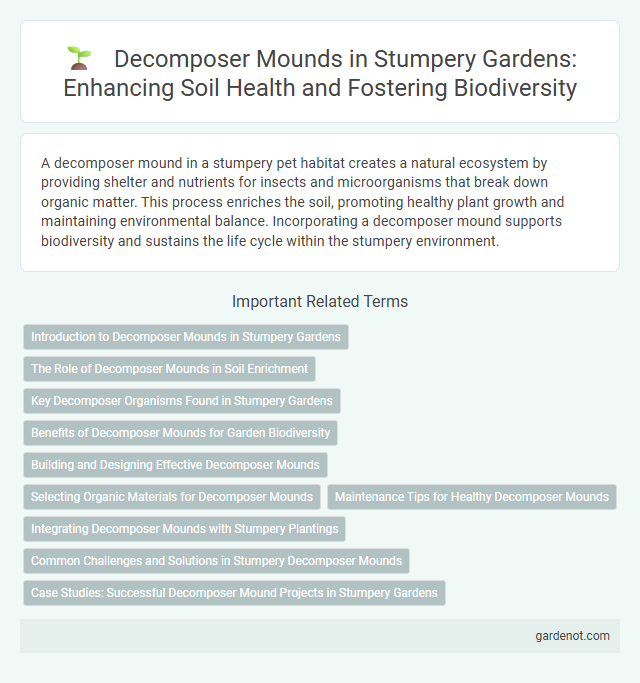A decomposer mound in a stumpery pet habitat creates a natural ecosystem by providing shelter and nutrients for insects and microorganisms that break down organic matter. This process enriches the soil, promoting healthy plant growth and maintaining environmental balance. Incorporating a decomposer mound supports biodiversity and sustains the life cycle within the stumpery environment.
Introduction to Decomposer Mounds in Stumpery Gardens
Decomposer mounds in stumpery gardens serve as vital ecosystems where wood and organic matter break down, enriching the soil with essential nutrients. These mounds support a diverse range of fungi, invertebrates, and microorganisms that accelerate decomposition and foster biodiversity. Integrating decomposer mounds enhances soil health and creates a dynamic habitat within the shaded, woody environment of a stumpery.
The Role of Decomposer Mounds in Soil Enrichment
Decomposer mounds in a stumpery play a crucial role in accelerating organic matter breakdown by providing an ideal habitat for fungi, bacteria, and invertebrates. These mounds enhance soil enrichment through the rapid recycling of nutrients like nitrogen, phosphorus, and potassium, which improve soil fertility and structure. The increased microbial activity within decomposer mounds promotes humus formation, boosting moisture retention and supporting plant health in surrounding areas.
Key Decomposer Organisms Found in Stumpery Gardens
Key decomposer organisms found in stumpery gardens include fungi such as saprotrophic mushrooms and mycorrhizal species that break down woody debris. Earthworms and various detritivorous insects like beetles and springtails contribute to organic matter decomposition by consuming and fragmenting plant material. Bacteria play a crucial role in nutrient cycling by decomposing complex organic compounds into simpler forms accessible to surrounding plants.
Benefits of Decomposer Mounds for Garden Biodiversity
Decomposer mounds in stumperies create nutrient-rich microhabitats by accelerating the breakdown of organic matter, enhancing soil fertility for diverse plant species. These mounds support a wide range of decomposer organisms such as fungi, bacteria, and detritivores, which play a critical role in nutrient cycling and maintaining ecosystem health. By fostering this microbial and invertebrate diversity, decomposer mounds contribute significantly to overall garden biodiversity and resilience.
Building and Designing Effective Decomposer Mounds
Building an effective decomposer mound starts with selecting a shaded, well-drained location to ensure optimal moisture retention and aeration for microbial activity. Layering diverse organic materials such as fallen leaves, wood chips, and compost creates a rich habitat that accelerates decomposition by supporting fungi, bacteria, and invertebrates essential for nutrient cycling. Designing the mound with varied textures and sizes of organic matter enhances structural complexity, promoting efficient breakdown and contributing to the ecological benefits within a stumpery.
Selecting Organic Materials for Decomposer Mounds
Choosing organic materials for decomposer mounds involves prioritizing a balanced mix of carbon-rich browns, such as dried leaves and wood chips, and nitrogen-rich greens like grass clippings and kitchen scraps. Incorporating diverse plant residues accelerates microbial activity and enhances nutrient cycling in the stumpery ecosystem. Proper layering of these materials ensures optimal decomposition rates and supports soil health improvement.
Maintenance Tips for Healthy Decomposer Mounds
Regularly turning the decomposer mound aerates organic material, accelerating decomposition and preventing foul odors. Maintaining moisture levels similar to a damp sponge supports microbial activity essential for nutrient cycling. Adding varied green and brown materials ensures a balanced carbon-to-nitrogen ratio, promoting efficient breakdown and healthy mound structure.
Integrating Decomposer Mounds with Stumpery Plantings
Integrating decomposer mounds with stumpery plantings enhances biodiversity by creating rich habitats for fungi, insects, and microorganisms vital to wood decay and nutrient cycling. Positioning decomposer mounds adjacent to stumperies accelerates organic matter breakdown, enriching soil fertility and supporting fern, moss, and shade-loving plant growth characteristic of traditional stumpery designs. This synergy promotes a sustainable ecosystem where decomposer activity and stumpery vegetation interact naturally to recreate ancient woodland floor environments.
Common Challenges and Solutions in Stumpery Decomposer Mounds
Decomposer mounds in stumperies often face common challenges such as poor aeration and excessive moisture, which can lead to slow decomposition and unpleasant odors. To optimize microbial activity, incorporating coarse woody debris and ensuring proper drainage by layering with materials like twigs and leaves helps maintain airflow. Periodic turning of the mound also accelerates decomposition, preventing anaerobic conditions and promoting nutrient-rich soil formation.
Case Studies: Successful Decomposer Mound Projects in Stumpery Gardens
Decomposer mound projects in stumpery gardens have demonstrated significant success in enhancing soil nutrient cycling and supporting biodiversity. Case studies reveal that integrating diverse organic materials, such as logs, leaf litter, and woody debris, fosters robust fungal networks and attracts key decomposer organisms like earthworms and mycorrhizal fungi. These projects contribute to sustainable ecosystem management by accelerating organic matter breakdown and improving microhabitat complexity in shaded woodland environments.
Decomposer mound Infographic

 gardenot.com
gardenot.com